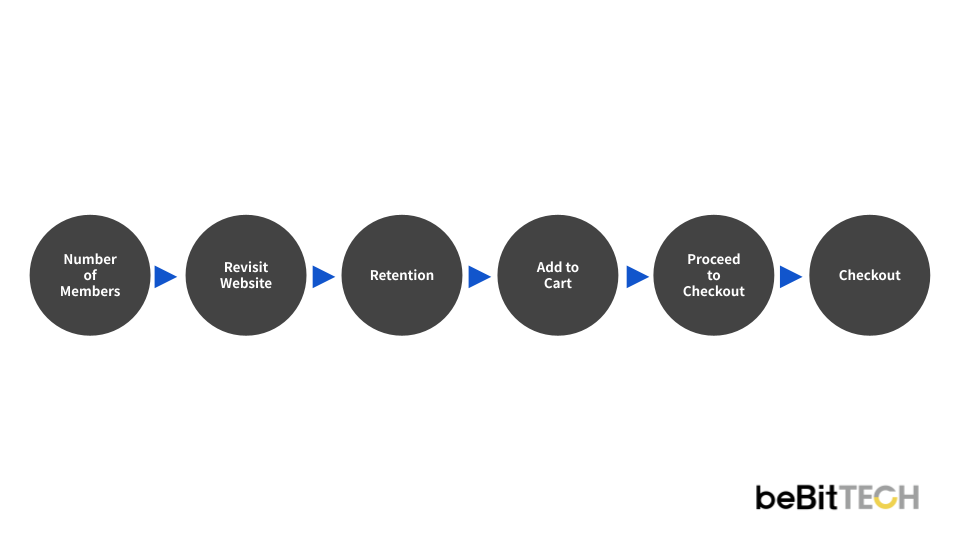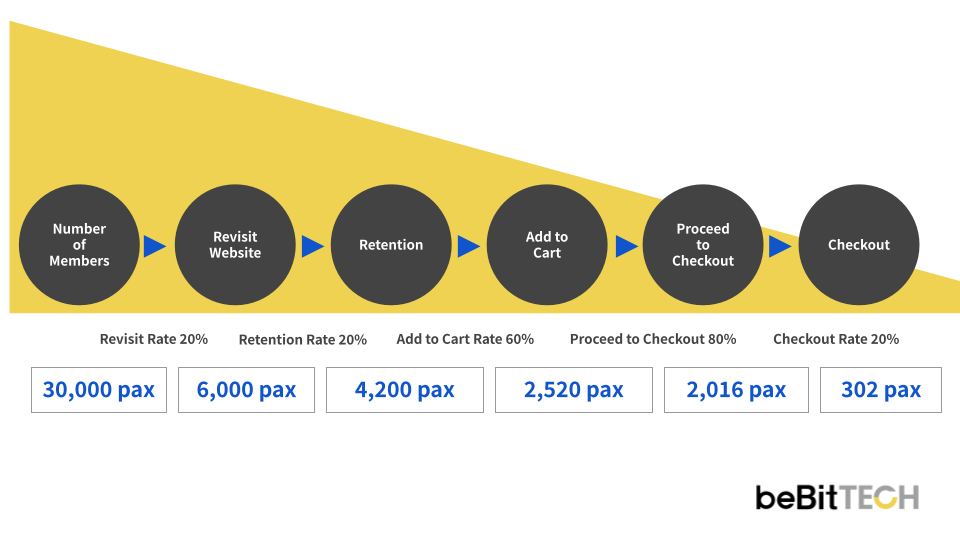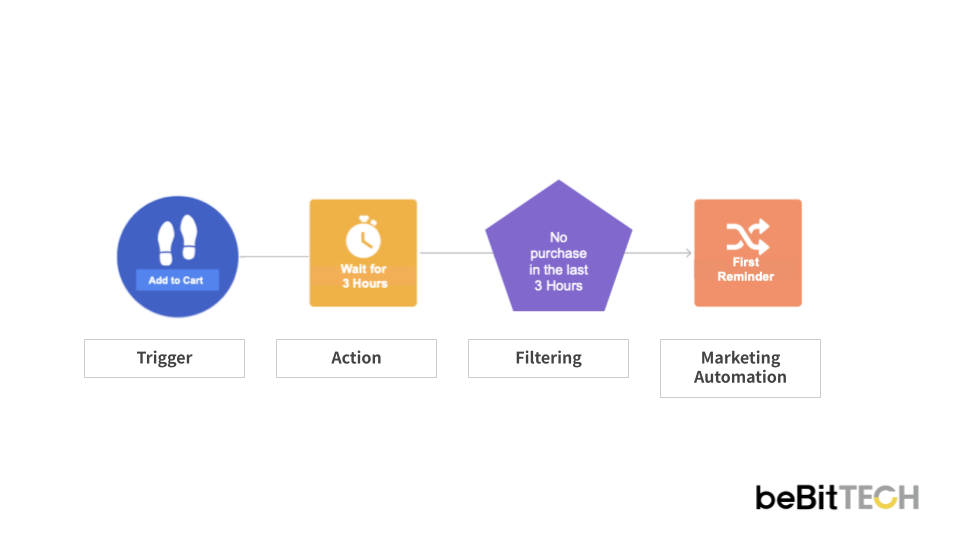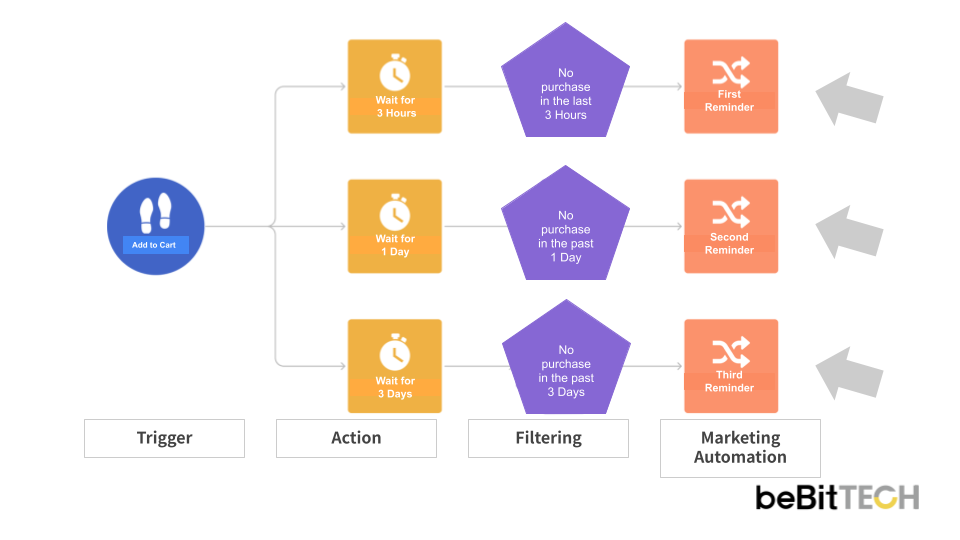Have you noticed that many consumers click the 'Add to Cart' button but then take no further action? It's time to set up an abandoned cart customer journey. By proactively using automated marketing (MA) to communicate in a timely manner, we can successfully encourage consumers to complete their purchases and clear their carts!
Customer Purchase Journey
Before discussing abandoned carts, we need to first understand the customer purchase journey on an e-commerce website.

As illustrated in the diagram above, consumers sequentially enter the website, browse pages (specific pages or product pages), click ‘Add to Cart,' proceed to the checkout page, and finally, make a purchase. These actions form a ‘customer purchase journey' funnel. At each stage of entering the funnel, there tend to be certain amount of customer drop-off.
Example
For example, as of March 1, 2022, the in-house brand ABC Fashion had 30,000 members. Observing these 30,000 members from March 1 to March 7, we found that the revisit rate was 20%, the retention rate was 70%, the add-to-cart rate was 60%, the checkout page entry rate was 80%, and the checkout completion rate was 20%. If we apply each percentage step-by-step, we get the following results: revisit count = 30,000 × 20% = 6,000 members, retention count = 6,000 × 70% = 4,200 members, add-to-cart count = 4,200 × 60% = 2,520 members, checkout page entry count = 2,520 × 80% = 2,016 members, and checkout completion count = 2,016 × 20% = 403 members.

By breaking down each stage, we can identify which stages are performing well, and which require improvement. The most straightforward and commonly focused-on stage is when customers add items to their cart but do not complete the checkout process.
How to Apply
Observe Historical Data → Set Expected Goals → Review Goal Performance → Maintain and Optimize
By setting goals, we establish a direction for optimization. This allows us to explore different marketing strategies to guide the metrics toward our desired outcomes.
Real-Time Monitoring of Cart Checkout Status
Suppose the weekly cart checkout rate is around 35% in the past, but dropped to 20% or rose to 50% this week out of sudden. Such anomalies warrant attention to understand the factors causing these changes.
Performance Breakdown
We can split performance metrics between new and returning customers to estimate the number of customers adding items to their carts and those that would be browsing. This helps in understanding the required traffic. However, since this article focuses on the abandoned cart customer journey, we will not delve deeper into this aspect here.
Utilizing OmniSegment CDP Automated Marketing to Establish an ‘Abandoned Cart' Customer Journey
What is a Customer Journey?
A customer journey is a designed scenario (such as an abandoned cart) where the performer (consumer) follows a set storyline.
As the name suggests, once a consumer clicks the ‘Add to Cart' button on an e-commerce website, they would've triggered the 'Add to Cart' customer journey automatically. If they do not make a purchase within the next 3 hours, or within a specified time frame, the system will automatically deliver a message (via Email, WhatsApp, SMS) to the consumer, reminding them to complete the purchase (optionally with a discount offer).
Building Customer Journeys using the OmniSegment CDP

The image above shows a simplified version of the abandoned cart customer journey in OmniSegment CDP. Brand owners are only required to prepare the contents to activate the customer journey, without additional resources required for the operation!

As illustrated, the application of the abandoned cart customer journey can be extended by using different channels (Email, WhatsApp, SMS) for real-time communication at three different intervals: no purchase within 3 hours of adding to cart, no purchase within one day of adding to cart, and no purchase within three days of adding to cart.
The Customer Journey Library Template
The OmniSegment CDP offers various scenario-specific templates for users to download. Besides the ‘abandoned cart' template, there are over a dozen others, including ‘welcome emails for registration' and ‘triggered communication by specific page clicks.' These automated marketing templates effectively help brands save up on resources.
Conclusion
By understanding the customer purchase journey, we can clearly identify the stages and indicators that can be optimized after customers visit the website. One of the most common and impactful optimization strategy is the abandoned cart reminder. Through the OmniSegment CDP, brands can leverage AI automation to automatically and instantly communicate with specific audiences (based on their site behaviors). This approach ensures personalized and effective communication, freeing up time and resources for brands.







